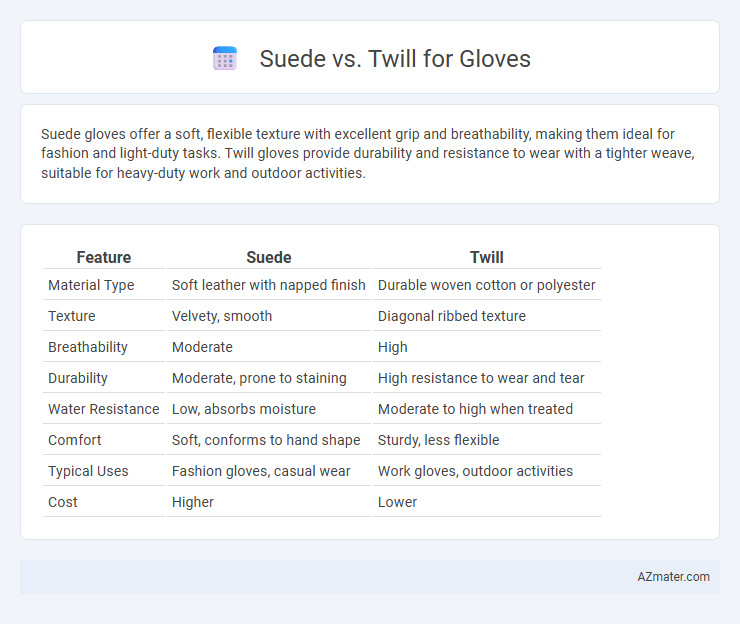Suede gloves offer a soft, flexible texture with excellent grip and breathability, making them ideal for fashion and light-duty tasks. Twill gloves provide durability and resistance to wear with a tighter weave, suitable for heavy-duty work and outdoor activities.
Table of Comparison
| Feature | Suede | Twill |
|---|---|---|
| Material Type | Soft leather with napped finish | Durable woven cotton or polyester |
| Texture | Velvety, smooth | Diagonal ribbed texture |
| Breathability | Moderate | High |
| Durability | Moderate, prone to staining | High resistance to wear and tear |
| Water Resistance | Low, absorbs moisture | Moderate to high when treated |
| Comfort | Soft, conforms to hand shape | Sturdy, less flexible |
| Typical Uses | Fashion gloves, casual wear | Work gloves, outdoor activities |
| Cost | Higher | Lower |
Introduction to Suede and Twill Gloves
Suede gloves feature a soft, napped finish created from the underside of animal hides, offering excellent grip and a luxurious texture ideal for precision tasks and cold weather. Twill gloves are crafted from tightly woven fabric with a distinctive diagonal pattern, providing durability, flexibility, and breathability suited for heavy-duty work and extended wear. Both materials excel in different applications, with suede prioritizing comfort and tactile sensitivity, while twill emphasizes strength and resilience.
Material Origins: What is Suede?
Suede is a type of leather made from the underside of animal hides, primarily from lamb, goat, or calf, characterized by its soft, napped finish achieved through sanding or buffing. This material offers a delicate texture with superior breathability and flexibility, making it ideal for gloves that require both comfort and dexterity. Unlike twill, which is a woven fabric commonly made from cotton or polyester, suede provides a natural, luxurious feel with enhanced grip and a distinctive appearance linked to its animal origin.
Understanding Twill: Features and Fabrication
Twill fabric, characterized by its distinctive diagonal weave pattern, enhances durability and flexibility, making it a preferred choice for gloves requiring both strength and comfort. This weaving technique results in a smooth surface with high resistance to abrasion and wrinkles, ensuring long-lasting performance in tough working conditions. Twill gloves often provide superior breathability and moisture management compared to suede, optimizing hand protection without sacrificing dexterity.
Durability Comparison: Suede vs Twill Gloves
Suede gloves offer superior durability due to their thick, dense leather fibers that resist abrasion and tearing, making them ideal for heavy-duty tasks and prolonged use. Twill gloves, constructed from tightly woven cotton or synthetic fibers, provide moderate durability with excellent flexibility and breathability but may wear out faster under rigorous conditions. When comparing both materials, suede stands out for long-lasting wear and enhanced protection, while twill prioritizes comfort with decent durability for lighter applications.
Comfort and Flexibility in Use
Suede gloves offer superior comfort due to their soft, supple texture that conforms well to hand movements, making them ideal for prolonged wear. Twill gloves provide exceptional flexibility because of their woven fabric structure, allowing for a better range of motion and reduced hand fatigue. Both materials balance durability and comfort, but suede excels in softness while twill prioritizes breathability and stretch.
Aesthetic Appeal: Look and Style Differences
Suede gloves showcase a soft, velvety texture that exudes a luxurious, matte finish ideal for sophisticated and vintage-inspired looks. Twill gloves feature a distinct diagonal weave pattern, providing a structured and casual appearance with subtle sheen that enhances durability and style. The choice between suede and twill significantly influences the glove's aesthetic appeal, with suede offering elegance and warmth and twill delivering practicality and a modern edge.
Maintenance and Cleaning Tips
Suede gloves require gentle maintenance using a soft brush or suede eraser to remove dirt and stains, avoiding water to prevent damage and discoloration. Twill gloves are easier to clean, often machine washable or hand washable with mild detergent, making them low-maintenance for everyday use. Proper storage for both materials involves keeping gloves in a cool, dry place to maintain texture and prevent mold or mildew.
Weather Suitability: Warmth & Breathability
Suede gloves offer superior warmth due to their dense, insulating fibers, making them ideal for cold, dry weather conditions. Twill gloves provide enhanced breathability with their lighter, woven fabric structure, which is better suited for mild or slightly cool climates. Choosing between suede and twill depends on balancing the need for heat retention against moisture management in varying weather environments.
Cost and Availability Considerations
Suede gloves generally have a higher cost due to the premium quality and intricate processing of natural leather, making them less available in budget-friendly markets. Twill gloves, made from tightly woven cotton or synthetic fibers, offer a more affordable option and greater availability across various price ranges and retailers. Cost-effectiveness and widespread accessibility make twill gloves preferred for everyday use, while suede remains a specialty choice for durability and luxury.
Choosing the Right Glove: Suede or Twill?
Suede gloves offer superior grip and durability, making them ideal for heavy-duty tasks and outdoor work where abrasion resistance is crucial. Twill gloves provide enhanced flexibility and breathability, suitable for lighter, precision tasks that require comfort and dexterity. Choosing the right glove depends on balancing protection needs with tactile sensitivity, ensuring optimal performance for specific work environments.

Infographic: Suede vs Twill for Glove
 azmater.com
azmater.com